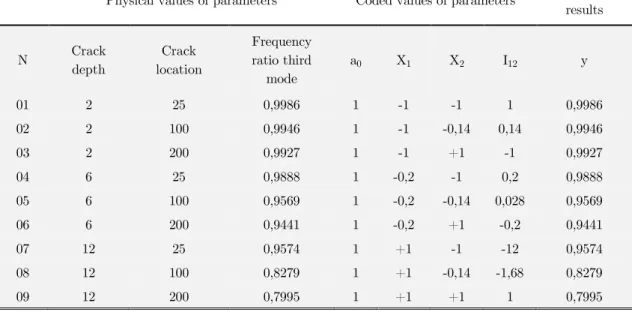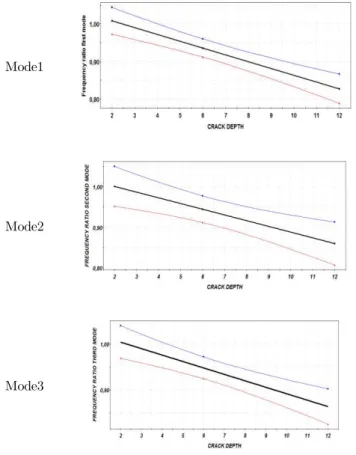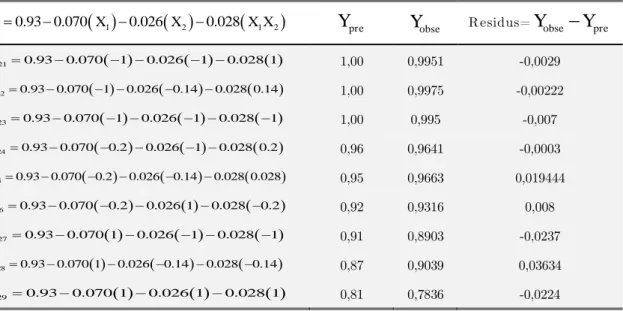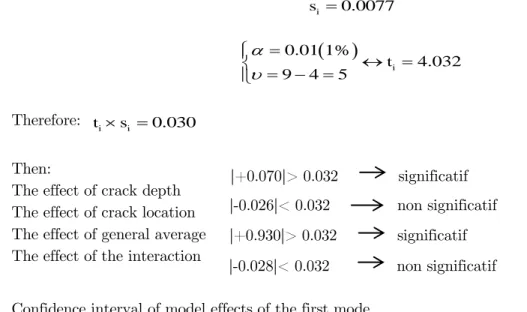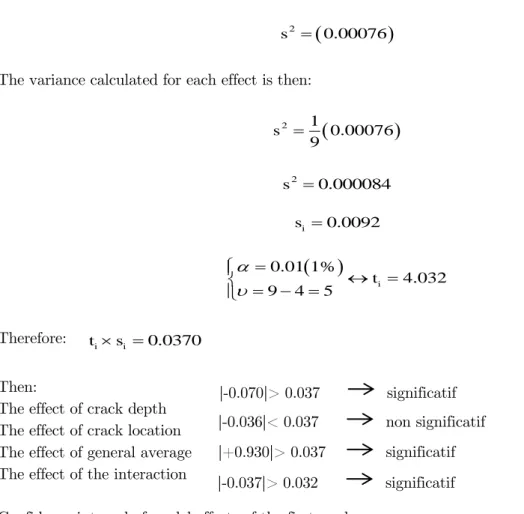Abstract
The understanding of phenomena, no matter their nature is based on the experimental results found. In the most cases, this requires an important number of tests in order to put a reliable and useful observation served into solving the technical problems subsequent-ly. This paper is based on independent and variables combination resulting from experimentation in a mathematical formulation. Indeed, mathematical modeling gives us the advantage to optimize and predict the right choices without passing each case by the experiment. In this work we plan to apply the experimental design method on the experimental results found by Deokar, A (2011), concerning the effect of the size and position of a crack on the measured frequency of a beam console, and validating the mathe-matical model to predict other frequencies
Keywords
Parameters, experimental design method, modeling, frequency, crack.
Modeling of Cracked Beams by the Experimental Design Method
1
INTRODUCTION
Several scientific works has been conducted on the experimental design method each in its field of
application and its objective, Bounazef M, Goupy J and Castro. L (2009, 1925, 2004). Other
au-thors Aît Yala (2009) have implemented experimental design using numerical results.
Experi-mental design were used for the first time by Fisher R (1925), in the field of agriculture where the
experimental parameters are numerous and significant which leads to mathematical modeling and
therefore to optimize the model sought. In mechanical terms, for example, Serier et al (2013a)
used experimental design method for optimizing the machining parameters in order to increase
the life of the tool. These same authors (2013b) performed a work in the field of vibration where
they showed the importance of the geometrical properties, the speed of rotation of a shaft (tree)
on the opening and closing mechanism of crack in a rotating machine. It is clear that the
phe-nomenon of cracking beams has negative consequences on the large industrial constructions,
Thomas, M (1995). The work of Deokar, A (2011) has focused on the experimental investigation
M. Serier a N. Benamara a A. Megueni a K. Refassi a
a Mechanics of Structures and Solids
Laboratory. Faculty of Technolgy, University of Sidi-Bel-Abbes, Bp 89, cité Ben M’hidi sidi- Bel-Abbes 22000-Algeria
http://dx.doi.org/10.1590/1679-78251403
Latin A m erican Journal of Solids and Structures 12 (2015) 1641-1652
for the detection of a crack on a cantilever used a criteria based on natural frequencies. Our work
consisted on the use of experimental design method for modeling and prediction of frequencies.
2 EXPERIMENTAL RESULTS FOR EACH FREQUENCY MODE
In the tables below, the experimental results of the variation of frequency ratio as a function of
position and depth of modes 1, 2 and 3 are presented. These results came from the work of Deokar
(2011).
Physical values of parameters Coded values of parameters Experimental results
N Crack
depth
Crack location
Frequency
ratio first mode a0 X1 X2 I12 y
01 2 25 0,9887 1 -1 -1 1 0,9887
02 2 100 0,9956 1 -1 -0,14 0,14 0,9956
03 2 200 0,9996 1 -1 +1 -1 0,9996
04 6 25 0,91 1 -0,2 -1 0,2 0,91
05 6 100 0,9626 1 -0,2 -0,14 0,028 0,9626
06 6 200 0,9966 1 -0,2 +1 -0,2 0,9966
07 12 25 0,6465 1 +1 -1 -12 0,6465
08 12 100 0,8081 1 +1 -0,14 -1,68 0,8081
09 12 200 0,9766 1 +1 +1 12 0,9766
Table 1: Frequency ratio of the various tests of the first mode and experience matrix.
Table 2: Frequency ratio of the various tests of the second mode and experience matrix.
Physical values of parameters Coded values of parameters Experimental results
N Crack depth
Crack location
Frequency ratio
second mode a0 X1 X2 I12 y
01 2 25 0,9951 1 -1 -1 1 0,9951
02 2 100 0,9975 1 -1 -0,14 0,14 0,9975
03 2 200 0,995 1 -1 +1 -1 0,995
04 6 25 0,9641 1 -0,2 -1 0,2 0,9641
05 6 100 0,9663 1 -0,2 -0,14 0,028 0,9663
06 6 200 0,9316 1 -0,2 +1 -0,2 0,9316
07 12 25 0,8903 1 +1 -1 -12 0,8903
08 12 100 0,9039 1 +1 -0,14 -1,68 0,9039
Latin A m erican Journal of Solids and Structures 12 (2015) 1641-1652 Physical values of parameters Coded values of parameters Experimental
results
N Crack
depth
Crack location
Frequency ratio third
mode
a0 X1 X2 I12 y
01 2 25 0,9986 1 -1 -1 1 0,9986
02 2 100 0,9946 1 -1 -0,14 0,14 0,9946
03 2 200 0,9927 1 -1 +1 -1 0,9927
04 6 25 0,9888 1 -0,2 -1 0,2 0,9888
05 6 100 0,9569 1 -0,2 -0,14 0,028 0,9569
06 6 200 0,9441 1 -0,2 +1 -0,2 0,9441
07 12 25 0,9574 1 +1 -1 -12 0,9574
08 12 100 0,8279 1 +1 -0,14 -1,68 0,8279
09 12 200 0,7995 1 +1 +1 1 0,7995
Table 3: Frequency ratio of the various tests of the third mode and experience matrix.
3 CALCULATIONS OF THE EFFECTS OF FACTORS
Each factor xi is affected (acted on) the behavior of the beam and it’s defined by the effect of
a
i. It
is possible that the factors interact with each other, this is the case in our work, and therefore we
are left with three factors, instead of two, including the average of these latter. In other words any
response
y
idepends on the action of all factors together xi. Analytically, and the relationship
be-tween the response factor can exist only when a certain proportionality exists bebe-tween them. This
leads us to write
:
n1 np p1
y
x
a
(1)
The Solve of system of equations is based on the least squares method, and the solution is noted a.
This solution is given by the following formula derived from the theory of matrix calculation.
(2)
Therefore
Coefficients Mode 1 Mode 2 Mode3
0,92 0,93 0,93
-0,090 -0,070 -0,070
0,076 -0,026 -0,036
0,081 -0,028 -0,037
Latin A m erican Journal of Solids and Structures 12 (2015) 1641-1652
The models are thus written in the following forms
Mode 1:
y1
0.92
0.090
X1
0.076
X2
0.081
X X1 2
Mode 2:
y2
0.93
0.070
X1
0.026
X2
0.028
X X1 2
Mode 3:
y
3
0.93
0.070
X
1
0.036
X
2
0.037
X X
1 2
4 ANALYSES WITH ONE VARIABLE FACTOR
4.1 Effect of Each Factor for the Three Modes
The figures below represent the effect of the two most principals factors (the crack depth and
posi-tion of the crack) for each mode of vibraposi-tion. We note that the ratio of the frequency is proporposi-tion-
proportion-al to the crack depth; the slope is negative regardless of the active mode. This confirms that the
propagation of a crack causes a decrease in the ratio of the frequency. In the case of the effect of
crack position on the frequency, we observed a change of the upward frequency in the first mode. In
other words, the more crack is remote from the recess the more important is the frequency, however
in the case of other modes (2 and 3) an opposite change is noticed with slopes more or less
im-portant. This is due to the values of the amplitudes of modes 2 and 3.
Mode1
Mode2
Mode3
Figure 1: Effect of the depth of the crack on the frequency for the three modes.
Latin A m erican Journal of Solids and Structures 12 (2015) 1641-1652
5 INTERACTION ANALYSE
Mode 1 Mode2 Mode3
(a) (b) (c)
Figure 3: Effect of the interaction of two factors on the frequencies for the three modes.
The analyze of the interaction between the depth and crack location was done by the help of a
rep-resentation of iso-courbes
Mode 1 Crack depth (2mm) Crack depth(12mm)
Crack location (25mm) 0,98 0,701
Crack location (200mm) 0,99 0,94
Table 5: The results of combined effects (mode1).
The figure 3a represents the effects of the two factors versus the ratio of frequency in mode 1. We
observed that there is just one near the abscissa of embedding and at low depths frequency ratio
reached the value of 0.98. This ratio decreases to great depths. For abscissa near the edge of the
beam, the depth of the crack has not effect. In the second and third mode analysis of iso-curves
(fig.3b, 3c) shows that the ratio reaches its maximum when the two factors are the lowest values
(tableaux 6 and 7)
Mode 2 Crack depth (2mm) Crack depth(12mm)
Crack location (25mm) 0,99 0,78
Crack location (200mm) 0,98 0,90
Table 6: The results of combined effects (mode 2).
Mode 3 Crack depth (2mm) Crack depth(12mm)
Crack location (25mm) 1,00 0,93
Crack location (200mm) 0,99 0,79
Latin A m erican Journal of Solids and Structures 12 (2015) 1641-1652
6 ANALYZE WITH THREE FACTORS
The mathematic models already established, they allowed us to calculate the predicted frequencies
and the residues for each mode (table 8, 9 and 10).
1 0.92 0.090 1 0.076 2 0.081 1 2
y X X X X
Y
preobse
Y
R esidus=Y
obse
Y
pre
11 0.92 0.090 1 0.076 1 0.081 1
y
12 0.92 0.090 1 0.076 0.14 0.081 0.14
y
1,02 1,01 0,9887 0,9956 -0,0263 -0,0151
13 0.92 0.090 1 0.076 1 0.081 1
y 1,01 0,9996 -0,0054
14 0.92 0.090 0.2 0.076 1 0.081 0.2
y 0,88 0,91 0,0318
15 0.92 0.090 0.2 0.076 0.14 0.081 0.028
y 0,93 0,9626 0,032972
16 0.92 0.090 0.2 0.076 1 0.081 0.2
y 1,00 0,9966 -0,0012
17 0.92 0.090 1 0.076 1 0.081 1
y 0,67 0,6465 -0,0265
18 0.92 0.090 1 0.076 0.14 0.081 0.14
y 0,80 0,8081 0,0081
19 0.92 0.090 1 0.076 1 0.081 1
y 0,99 0,9766 -0,0104
Table 8: Residues for the mode 1.
2 0.93 0.070 1 0.026 2 0.028 1 2
y X X X X
Y
preY
obse R esidus=Y
obse
Y
pre
21 0.93 0.070 1 0.026 1 0.028 1
y 1,00 0,9951 -0,0029
22 0.93 0.070 1 0.026 0.14 0.028 0.14
y 1,00 0,9975 -0,00222
23 0.93 0.070 1 0.026 1 0.028 1
y 1,00 0,995 -0,007
24 0.93 0.070 0.2 0.026 1 0.028 0.2
y 0,96 0,9641 -0,0003
25 0.93 0.070 0.2 0.026 0.14 0.028 0.028
y 0,95 0,9663 0,019444
26 0.93 0.070 0.2 0.026 1 0.028 0.2
y 0,92 0,9316 0,008
27 0.93 0.070 1 0.026 1 0.028 1
y 0,91 0,8903 -0,0237
28 0.93 0.070 1 0.026 0.14 0.028 0.14
y 0,87 0,9039 0,03634
29 0.93 0.070 1 0.026 1 0.028 1
y 0,81 0,7836 -0,0224
Latin A m erican Journal of Solids and Structures 12 (2015) 1641-1652
3
0.93 0.070
10.036
20.037
1 2y
X
X
X X
Y
preY
obse Residus =Y
obse
Y
pre
31 0.93 0.070 1 0.036 1 0.037 1
y 1,00 0,9986 -0,0004
32 0.93 0.070 1 0.036 0.14 0.037 0.14
y 1,00 0,9946 -0,00526
33 0.93 0.070 1 0.036 1 0.037 1
y 1,00 0,9927 -0,0083
34 0.93 0.070 0.2 0.036 1 0.037 0.2
y 0,97 0,9888 0,0162
35 0.93 0.070 0.2 0.036 0.14 0.037 0.028
y 0,95 0,9569 0,008896
36 0.93 0.070 0.2 0.036 1 0.037 0.2
y 0,92 0,9441 0,0287
37 0.93 0.070 1 0.036 1 0.037 1
y 0,93 0,9574 0,0244
38 0.93 0.070 1 0.036 0.14 0.037 0.14
y 0,87 0,8279 -0,04232
39 0.93 0.070 1 0.036 1 0.037 1
y 0,79 0,7995 0,0125
Table 10: Residues for the mode 3.
With the help of the statistics calculations, we were able to define the effects the most significant of
the factors and their gaps of confidence (trust), all with calculating the residues ei. The residues are
the difference between the experimental value and predicted value by the mathematic model
(fig-ure4) and they are linked by the linear regression.
Figure 4: Distribution of the experimental points from the mathematical model for each mode.
7 REALIZATION OF THE TEST OF EFFECTS SIGNIFICANCE
The test used is the Student test << t>>. An effect is said significant (that is to say that the
in-teraction or the variable associated with it has an influence on the response), if, for a given risk
significantly different from 0. So we test the hypothesis
Hypothesis:
Latin A m erican Journal of Solids and Structures 12 (2015) 1641-1652
For this, we calculate
i i i
a
t
s
(3)
Student table is then used to v= n
–
p degrees of freedom (n is the number of experiments and p is
the number of effects including the constant). The risk of a first species is selected (usually 1% or
5%) and is read in the table of the Student t value, using the part of the table related to a bilateral
test.
Mode 1:
2
1
2i
s e
n p
(4)
2 2 2 2 2 2
2
2 2 2
1
0.0263 0.0151 0.0054 0.0318 0.032972 0.0012
9 4
0.0265 0.0081 0.0104
s
21
0.0039
5
s
20.00078
s
The variance calculated for each effect is then:
21
0.00078
9
s
20.000086
s
0.0093
i s
0.01 1%
4.032
9
4
5
ti
(5)
Therefore:
ti
si0.037
The effect of crack depth :
The effect of crack location
The effect of general average
The effect of the interaction :
│
-0.09
0│> 0.03
7
significatif
│
+0.92
0│> 0.03
7
significatif
│
-0.810
│< 0.03
7
significatif
Latin A m erican Journal of Solids and Structures 12 (2015) 1641-1652
Confidence interval of model effects of the first mode
[a
i- t (
α
,
ν
) s
i; a
i+ t (
α
,
ν
) s
i]
(6)
ai-(t(α,ν) *si) ai ai+ (t (α,ν) *si)
-0,127 C
rack depth
-0,09 -0,0530,039
Crack location
0,076 0,1130,044 Interaction 0,081 0,118
Table 11: Confidence interval of model effects of the first mode.
Figure 5: Confidence interval of model effects of the first mode.
Mode
2:
2
1
2i
s e
n p
2 2 2 2 2 2
2
2 2 2
1
0.000008 0.000004 0.00004 0.00000009 0.0003 0.00006
9 4
0.0005 0.0013 0.0005
s
2
1
0.0028
5
s
2
0.00057
s
The variance calculated for each effect is then:
2
1
0.00057
9
s
2
0.000060
Latin A m erican Journal of Solids and Structures 12 (2015) 1641-1652
0.0077
i
s
0.01 1%
4.032
9
4
5
ti
Therefore:
ti
si0.030
Then:
The effect of crack depth :
The effect of crack location :
The effect of general average :
The effect of the interaction :
Confidence interval of model effects of the first mode
[a
i- t (
α
,
ν
) s
i; a
i+ t (
α
,
ν
) s
i]
ai-(t(α,ν) *si) ai ai + (t (α,ν) *si)
-0,098 Crack depth -0,07 -0,038
-0,05824 Crack location -0,026 0,006
-0,06024 Interaction -0,028 0,004
Table 12: Confidence interval of model effects of the second mode.
Figure 6: confidence interval of model effects of the second mode.
Mode 3:
2
1
2i
s e
n p
2 2 2 2 2 2
2
2 2 2
1
0.0004 0.00002 0.000068 0.00026 0.00007 0.00082
9 4
0.00059 0.0017 0.00015
s
│
+
0.070│> 0.032
significatif
│
+
0.930│> 0.032
significatif
│
-0.028
│< 0.032
non significatif
Latin A m erican Journal of Solids and Structures 12 (2015) 1641-1652
2
1
0.0038
5
s
2
0.00076
s
The variance calculated for each effect is then:
2
1
0.00076
9
s
2
0.000084
s
0.0092
i
s
0.01 1%
4.032
9
4
5
ti
Therefore:
ti
si0.0370
Then:
The effect of crack depth :
The effect of crack location :
The effect of general average :
The effect of the interaction :
Confidence interval of model effects of the first mode
[a
i- t (
α
,
ν
) s
i; a
i+ t (
α
,
ν
) s
i]
ai -(t(α,ν) *si)
ai ai + (t (α,ν) *si)
-0,107 Crack depth -0,07 -0,033
-0,073 Crack location -0,036 0,001
-0,074 Crack depth -0,037 0
Table 13: Confidence interval of model effects of the third mode.
│
-
0.070│> 0.03
7
significatif
│
+
0.930│> 0.03
7
significatif
│
-0.0
37│>
0.032
significatif
Latin A m erican Journal of Solids and Structures 12 (2015) 1641-1652
Figure 7: Confidence interval of model effects of the third mode.
8 CONCLUSIONS
Using the method of experimental design allows to extract the maximum information at a
reasona-ble cost and minimum time. In our case, we have:
1) Modeled the vibration behavior of a cracked beam console
2) Plotted the iso-curves for different modes of vibration
These curves allow the choice according to the needs of the operating state (condition) of the beam.
It further notes that:
The depth of the crack remains significantly regardless of the current mode vibration, while this is
not the case for the location of the crack which is significant only in the first mode.
The interaction between the two factors of an unexplained way varies from one mode to another; in
the first mode of interaction is significant, it is only slightly in the third mode when it no longer is
in the second mode
References
Deokar, A. A.V, Wakchaure,B. V.D. (2011). Experimental Investigation of Crack Detection in Cantilever Beam Using Natural Frequency as Basic Criterion, INSTITUTE OF TECHNOLOGY, NIRMA UNIVERSITY, AHMEDABAD – 382 481
Bounazef ,M., Djeffal ,A., Serier ,M.and Adda ,BEA. (2009). Optimization by behavior modeling of a protective porous material. Journal of the Computational Materials Science. 44(3):921-928.
Fisher,R. (1925). Statistical Methods for Research Workers. Oliver and Boyd;. PMid: 17246289 Castro.L, Viéville.P, and Lipinski.P, Phys. J(2006).IV France 134, 1273.
A. Ait Yala , A. Megueni, (2009) Optimisation of composite patches repairs with the design of experiments method, Mate-rials and Design pp 200–205
Thomas, M., Nguyen, H., Hamidi,L., Massoud ,M. and Piaud J.B. (1995). Detection of rotor cracks by experi-mental modal analysis, Transactions of the Canadian Society of Mechanical Engineering, 19(2): pp 155-174.
Refassi,K. Serier, M. and Lousdad ,A. (2013). DOE Analysis of Feed and Cutting Speed Effects on Frequency Dur-ing MachinDur-ing Operations, Advanced Science Letters Vol. 19, 942–945.

